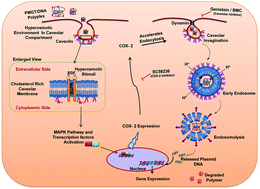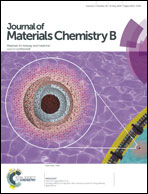Highly efficient gene transfection by a hyperosmotic polymannitol based gene tranporter through regulation of caveolae and COX-2 induced endocytosis†
Abstract
The regulation of cellular uptake to cross the cell membrane is one of the key strategies of importance for efficient gene transfection of non-viral vectors. Hyperosmotic activity of polyplexes may facilitate crossing of the membrane barrier by elevating the osmolarity of the extracellular matrix. In this study, we demonstrated that a polymannitol based gene transporter (PMGT) utilizes the hyperosmoticity contributed by the polymannitol backbone leading to accelerated cellular uptake and enhanced gene transfection. Mannitol dimethacrylate (MDM) monomer was synthesized by esterification of mannitol and methacryloyl chloride. The prepared MDM was then cross-linked with low molecular weight (LMW) branched polyethyleneimine (bPEI) by Michael addition reaction to produce PMGT. PMGT provided polyplex stability in serum, low cytotoxicity, and degradability due to the ester linkages present in the polymannitol backbone. Elevated transfection activity and efficiency, both in vitro and in vivo, were achieved by modulating the mode of cellular uptake due to the effect of the hyperosmotic properties of PMGT. Cyclooxygenase-2 (COX-2) inhibition by SC58236 revealed the up-regulation of this osmoprotectant molecule against the hyperosmotic activity of polymannitol, inducing rapid endocytosis of PMGT in order to re-balance the hyperosmotic environment. Various inhibition studies of endocytosis showed caveolae-mediated endocytosis to be the main route of cellular internalization to account for the enhanced transgene expression.


 Please wait while we load your content...
Please wait while we load your content...